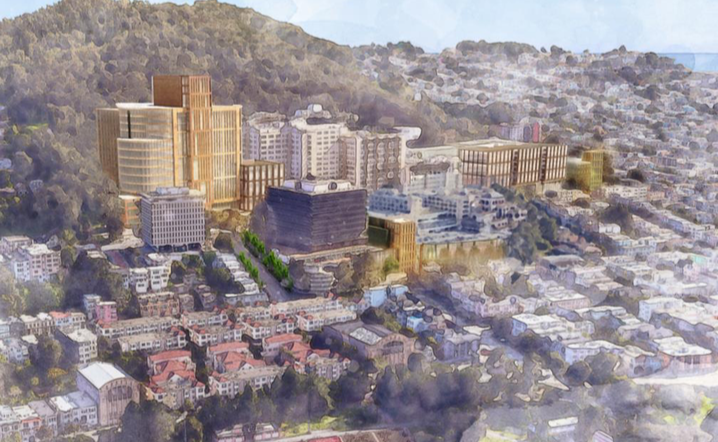An Alameda County judge has blocked the University of California from moving forward on its massive planned demolition and construction on Parnassus Heights.
Judge Frank Roesch approved Friday at temporary restraining order barring the school from any action that would threaten the historic Zackheim murals at Toland Hall.

Since that’s the main area that UC has been preparing for construction, the order in effect slows down a project that violates the school’s longtime legal promises to the neighborhood.
The school says it can remove and save the frescos without damage; that’s a matter of considerable dispute.
But the issue is much larger.
In 1976, UC made a binding promise to limit its footprint on Parnassus Heights—in the middle of a dense residential neighborhood—to 3.55 million gross square feet.
As recently as 2014, the school’s long-range development plan confirmed that commitment and limit.
But in 2019, with almost no community input, UCSF decided to move forward with a plan that would add another 1.5 million square feet to the campus.
Because UCSF is a state agency, it’s exempt from the city’s normal requirements for affordable housing, Muni fees, and other city requirements.
The impacts are dramatic. From our 2019 story:
In May of this year, the city released a study by Keyser Marston Associates analyzing the relationship between job growth and housing demand. Based on that study 1.5 million square feet of combined office, medical and research space will generate a demand for 2,850 housing units, 970 of which would need to be affordable.
That number includes 87 units of extremely-low-income, 102 very-low income, 278 of low-income and 500 units of moderate-income housing. When that’s combined with the deficit in affordable housing created by roughly 3 million square feet in UCSF’s new Mission Bay campus, the effect on housing demand is tripled.
Based upon that same study, the Mission Bay campus has generated a demand for about 5,700 units of housing, of which 1,942 should be below market rate.
UC is not doing anything close to that.
Lawyers for UC argued that the school wasn’t going to damage the murals in moving them and that there is no issue here under the California Environmental Quality Act.
But San Franciscans for Balanced and Livable Communities, a neighborhood group, argues in court that
Cutting the Zakheim Murals from the walls of UC Hall/Toland Hall and removing them threatens to destroy them. These are priceless historical and cultural resources. Yet, Respondents refuse to provide information as to when this activity will take place. Removing the Zakheim Murals is the first step in demolishing UC Hall/Toland Hall, which is a recognized historic resource, and the CPHP EIR finds that demolishing this building and many other buildings slated for demolition will cause significant, but purportedly unavoidable, environmental harm. The EIR admits that demolition of these buildings will cause significant adverse environmental impacts.
The case will be back in court Sept. 16, when the neighbors will argue for a permanent injunction—which at the very least could send the rather arrogant folks who run UCSF back to negotiating with the community that has to deal with the impacts of their project.
As Dennis Antenore, a former SF Planning Commission member and a leader in the neighborhood struggle, put it:
In this case the university attempted to hide its work to remove the Zakheim murals from Toland Hall and commence the demolition of this historic building. After having promised to give the public advanced notice of any construction activities, it began significant work prior to notifying the public in an obvious attempt to avoid public scrutiny. It is gratifying that Judge Roesch saw through the misrepresentations and disingenuous arguments of the university’s attorneys. This is only a temporary victory and the hearing on the preliminary injunction is to be heard on September 16th. We will do everything we can to make sure that the Judge is informed of the true facts prior to his decision.




